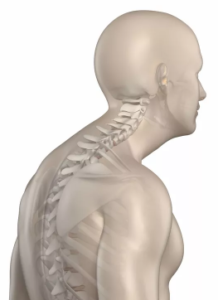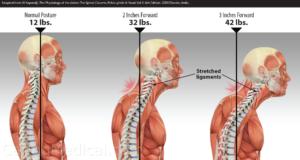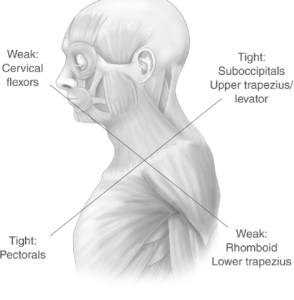Why does my head stick forward?
 Have you seen a picture of yourself from the side and seen that your head seems to be poking forwards in relation to your shoulders, or maybe you have noticed that you have developed a bit of a lump at the base of your neck? If that sounds like you, then you may have developed a forward head posture. In this article, we will explain what forward head posture is, how it may affect you, and how to improve it.
Have you seen a picture of yourself from the side and seen that your head seems to be poking forwards in relation to your shoulders, or maybe you have noticed that you have developed a bit of a lump at the base of your neck? If that sounds like you, then you may have developed a forward head posture. In this article, we will explain what forward head posture is, how it may affect you, and how to improve it.
WHAT IS FORWARD HEAD POSTURE
Forward head posture is described as ‘an anterior (forward) position of the head in relation to the vertical line of the body’s centre of gravity’ (1), this gives the impression that the person looks like they are sticking their chin forward. This has been recently referred to in the media as ‘tech neck’, or ‘screen neck’, which makes it sound like it is a new thing, but this type of posture has always been around.
WHAT CAUSES FORWARD HEAD POSTURE?
 Forward head posture is a common postural pattern that is more likely to be seen in women, ex-smokers, and people with high job demands (2). People who spend long periods at a computer without being mindful of their workstation set up and sitting posture are also more likely to develop forward head posture (3). The change in head position alters the effect of gravity on the tissues of the neck and back placing increased loads on the tissues and changing how these tissues perform (1). As the head moves forward, it begins to place demands on the structure of the neck that are not suited to the task; the further forward the head goes, the larger those forces become (4).
Forward head posture is a common postural pattern that is more likely to be seen in women, ex-smokers, and people with high job demands (2). People who spend long periods at a computer without being mindful of their workstation set up and sitting posture are also more likely to develop forward head posture (3). The change in head position alters the effect of gravity on the tissues of the neck and back placing increased loads on the tissues and changing how these tissues perform (1). As the head moves forward, it begins to place demands on the structure of the neck that are not suited to the task; the further forward the head goes, the larger those forces become (4).
WHAT PROBLEMS CAN FORWARD HEAD POSTURE CAUSE?
 Neck pain – The changes around the neck can lead to a reduced ability to move the neck freely, typically the muscles of the back of the upper part of the neck become shortened, and the muscles of the upper back, shoulders, and front of the neck become weaker, all of which places more load on the spinal column and joints leading to higher chance of neck pain (5,6). However, as is often the case in the body, nothing happens in isolation so a forward head posture can often be due to, or cause changes in the posture and performance in other areas.
Neck pain – The changes around the neck can lead to a reduced ability to move the neck freely, typically the muscles of the back of the upper part of the neck become shortened, and the muscles of the upper back, shoulders, and front of the neck become weaker, all of which places more load on the spinal column and joints leading to higher chance of neck pain (5,6). However, as is often the case in the body, nothing happens in isolation so a forward head posture can often be due to, or cause changes in the posture and performance in other areas.
Headaches – people who have a forward head posture are more likely to suffer from tension headaches (7). This is likely to be due to spasm of the suboccipital muscles and the associated blood vessels at the top of the neck, which have become tight and constricted due to the change in head position. It has been shown that treating the suboccipital muscles with massage-like techniques and prescribing posture correction exercises will help with both tension headaches and forward head posture (7, 8).
Changes in Breathing – Forward head posture also affects the spine in the thorax, often decreasing its ability to move effectively. This in turn reduces chest expansion, changes the vital mechanics of the lower ribs and diaphragm, and results in a reduced ability of the alveoli in the lungs to properly ventilate (9). It has also been suggested that the nerve which supplies the diaphragm, the phrenic nerve (which exits the spine from the neck), may have its function altered by forward head posture, leading to changes in how it performs its primary function of the movements necessary for effective breathing. People with forward head posture have been shown to have reduced peak flow volumes and the maximum inspiration and expiration volume of the lungs (10). This effect is especially relevant for aerobic athletes and sufferers of chronic breathing difficulties such as asthma.
for effective breathing. People with forward head posture have been shown to have reduced peak flow volumes and the maximum inspiration and expiration volume of the lungs (10). This effect is especially relevant for aerobic athletes and sufferers of chronic breathing difficulties such as asthma.
Shoulder Pain – As touched upon earlier, the changes in the neck seen in forward head posture also impact the upper back and, therefore, the shoulders. In people who have forward neck posture, it is common to see the shoulder blades move away from the spine due to tight pectoral muscles and a lack of power in the muscles in the middle of the back, which then makes the shoulder joint turn inwards giving the person a ‘rounded shoulder’ appearance. These changes are associated with an increase in shoulder pain (11).
 HOW TO FIX FORWARD HEAD POSTURE
HOW TO FIX FORWARD HEAD POSTURE
Firstly, you can have forward head posture and not have any pain or dysfunction that we have described above. Most people, if they spend a lot of time at a computer, will get a stiff neck; this is most commonly addressed by changing your workstation set-up, or getting better at taking regular breaks from the screen. However, if you have a more pronounced forward head posture and you are struggling with some persistent neck pain and stiffness, headaches, or shoulder pain, then you may benefit from specific advice on your workstation set up, some manual therapy, and some corrective exercises (12).
To fix forward head posture, three issues need to be addressed;
Workstation Set-Up – The factors that have produced the issue need to be reduced. If it is most likely to be due to improper workstation set-up, then advice on reducing the use of a laptop, screen height and distance in relation to the user, and keyboard positioning can all be very helpful.
Stretching Tight Areas – Massage-like techniques and manipulation of joints that have become stiff, can be very helpful in reducing any pain and increasing the movement in the neck and upper back. This may also help with headaches associated with forward head posture (7, 8, 13). The muscles of the upper neck (suboccipitals, upper trapezius) and the upper chest (pectorals, scalenes, sternocleidomastoid) are areas that, if stretched, can help reduce forward head posture.
Strengthening Weak Muscles – To make a decisive change in forward head posture is also necessary to strengthen specific muscles in and around the upper body, the most productive areas are usually the deep neck flexors, the rhomboids, and mid trapezius (12).
It is our experience as osteopaths that to make a lasting change in people with forward head posture all three elements must be addressed.
Have you noticed that your head and neck are beginning to stick forward, or are you experiencing any neck pain or headaches?
Why not take advantage of our new patient assessment introductory offer to get you started towards a tailor-made recovery plan for only £19.
Are you in a lot of pain and want to get better as soon as possible? If so then why not book in for a new patient consultation, with treatment on the day, for £75.
REFERENCES
1 – Arun V. Subbarayalu, Mariam A. Ameer. Relationships among head posture, pain intensity, disability and deep cervical flexor muscle performance in subjects with postural neck pain, Journal of Taibah University Medical Sciences, Volume 12, Issue 6, 2017, Pages 541-547,https://doi.org/10.1016/j.jtumed.2017.07.001.
2 – Mahmoud NF, Hassan KA, Abdelmajeed SF, Moustafa IM, Silva AG. The relationship between forward head posture and neck pain: a systematic review and meta-analysis. Current reviews in musculoskeletal medicine. 2019 Dec;12(4):562-77.
3 – I. Gadotti, D. Biasotto-Gonzalez. Sensitivity of clinical assessment of head posture in sagittal plane-A preliminary study. J Eval Clin Pract, 16 (2010), pp. 141-144.
4 – Hansraj KK. Assessment of stresses in the cervical spine caused by posture and position of the head. Surg Technol Int. 2014 Nov 1;25(25):277-96
5 – K.T. Lau, K.Y. Cheung, K.B. Chan, M.H. Chan, K.Y. Lo, T.T.W. Chiu. Relationship between sagittal postures of thoracic and cervical spine, presence of neck pain, neck pain severity and disability. Man Ther, 26 (2010), pp 457-462
6 – Burt HA, Effects of faulty posture; President’s Address. Proc R Soc Med. 1950; 43(3):187–194. Accessed 26 February 2019.
7 – Cho SH. The effect of suboccipital muscle inhibition and posture correction exercises on chronic tension-type headaches. Journal of Back and Musculoskeletal Rehabilitation. 2021;34(6):989-996. doi:10.3233/BMR-191667.
8 – Fernández-de-las-Peñas C Alonso-Blanco C Cuadrado ML Gerwin RD Pareja JA. Trigger points in the suboccipital muscles and forward head posture in tension-type headache. Headache: The Journal of Head and Face Pain. 2006; 46(3): 454-460.
9 – Triangto K, Widjanantie SC, Nusdwinuringtyas N. Biomechanical Impacts of Forward Head Posture on the Respiratory Function. Indonesian Journal of Physical Medicine & Rehabilitation. 2019;8(02):50-64.
10 – Koseki T, Kakizaki F, Hayashi S, Nishida N, Itoh M. Effect of forward head posture on thoracic shape and respiratory function. Journal of Physical Therapy Science. 2019;31(1):63-8.
11 – Fathollahnejad, K., Letafatkar, A. & Hadadnezhad, M. The effect of manual therapy and stabilizing exercises on forward head and rounded shoulder postures: a six-week intervention with a one-month follow-up study. BMC Musculoskelet Disord 20, 86 (2019). https://doi.org/10.1186/s12891-019-2438-y
12 – Im B, Kim Y, Chung Y, Hwang S. Effects of scapular stabilization exercise on neck posture and muscle activation in individuals with neck pain and forward head posture. Journal of physical therapy science. 2015;28(3):951-5.
13 – Szczygieł E, Sieradzki B, Masłoń A, Golec J, Czechowska D, Węglarz K, Szczygieł R, Golec E. Assessing the impact of certain exercises on the spatial head posture. International journal of occupational medicine and environmental health. 2019 Feb 27;32(1):43-51.


 HOW TO FIX FORWARD HEAD POSTURE
HOW TO FIX FORWARD HEAD POSTURE